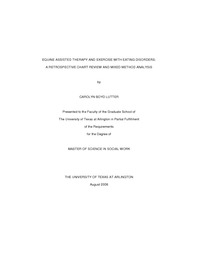
ATTENTION: The works hosted here are being migrated to a new repository that will consolidate resources, improve discoverability, and better show UTA's research impact on the global community. We will update authors as the migration progresses. Please see MavMatrix for more information.
Show simple item record
| dc.contributor.author | Lutter, Carolyn Boyd | en_US |
| dc.date.accessioned | 2008-09-17T23:35:12Z | |
| dc.date.available | 2008-09-17T23:35:12Z | |
| dc.date.issued | 2008-09-17T23:35:12Z | |
| dc.date.submitted | July 2008 | en_US |
| dc.identifier.other | DISS-2237 | en_US |
| dc.identifier.uri | http://hdl.handle.net/10106/1122 | |
| dc.description.abstract | Eating disorders are a group of devastating mental illnesses that chronically affect millions of young women and men of all ages and ethnicities in industrialized nations. Mainstream treatment approaches thus far have proven to have variable efficacy and outcomes and new behavioral interventions such as equine assisted therapy and exercise deserve to be considered as a viable intervention with this population.
The area of equine assisted therapy in the field of eating disorder research has received disproportionately little attention. Given the number of residential treatment facilities that integrate it into their treatment for eating disorders, evidence of its safety and efficacy is warranted. Exercise, however, has been investigated with eating disorder patients. Empirical evidence indicates physical activity intervention is not only safe for this population, it improves a range of biopsychosocial outcomes. Yet exercise is not a standard adjunct treatment for people with eating disorders as it is mainly viewed as a part of the pathology of the mental illness or as a method of weight loss for a proportion of this population. Reframing physical activity in terms of how it benefits patients will be a challenge for clinicians without further evidence.
In this study, equine therapy notes at a residential treatment facility were examined to determine type (ground vs. mounted and group vs. one on one), duration, and intensity of physical activities, as well as perceived improvements in psychological well-being. Patient demographics and scores for the Beck Depression Inventory - II and Eating Disorder Inventory - 2 provided further data to determine whether equine assisted therapy and the physical activity during sessions were associated with improved outcomes for patients.
Results indicate physical activity involved in equine therapy is safe and plays a role in eating disorder symptom improvements. The amount of energy spent in physical activity in equine assisted therapy accounted for 14.3% of Beck Depression Inventory - II discharge scores and 24.8% of changes in Eating Disorder Inventory - 2 scores, regardless of eating disorder diagnosis. The qualitative analysis revealed themes of improved psychological well-being from equine assisted therapy for those patients whose length of stay was 30 days or more: asserting needs, identifying contributing factors to the eating disorder, asking for help, problem solving, thinking positively, and verbalizing feelings of frustration.
The key findings illuminate the value of equine assisted therapy with the eating disorder population. In conclusion, this type of therapy is valid and will help clinicians to better identify those patients who would benefit the most from equine assisted therapy. Likewise, the positive association of physical activity with improved mood and eating disorder symptoms legitimizes exercise as an intervention. These are exciting and promising findings for patients with eating disorders and clinicians alike who wish to include physical activity with equine assisted therapy in treatment plans. | en_US |
| dc.description.sponsorship | Smith-Osborne, Alexa | en_US |
| dc.language.iso | EN | en_US |
| dc.publisher | Social Work | en_US |
| dc.title | Equine Assisted Therapy And Exercise With Eating Disorders: A Retrospective Chart Reveiw And Mixed Method Analysis | en_US |
| dc.type | M.S.S.W. | en_US |
| dc.contributor.committeeChair | Smith-Osborne, Alexa | en_US |
| dc.degree.department | Social Work | en_US |
| dc.degree.discipline | Social Work | en_US |
| dc.degree.grantor | University of Texas at Arlington | en_US |
| dc.degree.level | masters | en_US |
| dc.degree.name | M.S.S.W. | en_US |
| dc.identifier.externalLink | https://www.uta.edu/ra/real/editprofile.php?onlyview=1&pid=1341 | |
| dc.identifier.externalLinkDescription | Link to Research Profiles | |
Files in this item
- Name:
- umi-uta-2237.pdf
- Size:
- 29.13Mb
- Format:
- PDF
This item appears in the following Collection(s)
Show simple item record


